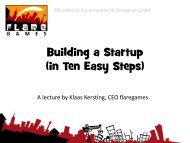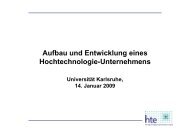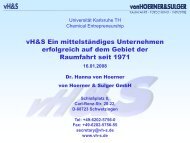Education in Chemical Entrepreneurship - KIT - Technology ...
Education in Chemical Entrepreneurship - KIT - Technology ...
Education in Chemical Entrepreneurship - KIT - Technology ...
You also want an ePaper? Increase the reach of your titles
YUMPU automatically turns print PDFs into web optimized ePapers that Google loves.
Apart from drivers by national policy (programs, <strong>in</strong>itiatives, <strong>in</strong>centives etc.)<br />
<strong>in</strong>novation and entrepreneurship for found<strong>in</strong>g NTBFs or RBSUs can be associated<br />
with effects of the national science and technology system, the particular<br />
scientific/eng<strong>in</strong>eer<strong>in</strong>g discipl<strong>in</strong>e and the specific related <strong>in</strong>dustry <strong>in</strong>clud<strong>in</strong>g the modes<br />
of <strong>in</strong>teractions between exist<strong>in</strong>g and new firms, such as cooperation and various forms<br />
of alliances, or fund<strong>in</strong>g and ownership through corporate ventur<strong>in</strong>g. Such an approach<br />
<strong>in</strong>troduces more country-specific features <strong>in</strong>to (technology) entrepreneurial education<br />
than is commonly found <strong>in</strong> “standard” textbooks (e.g. Dorf and Byers 2007).<br />
The above outl<strong>in</strong>es of understand<strong>in</strong>g implied major consequences for the design of the<br />
entrepreneurship curriculum. Notably. the scope of the curriculum will comprise<br />
entrepreneurship to found new firms as well as entrepreneurship <strong>in</strong> established firms<br />
(“<strong>in</strong>trapreneurship”). Our <strong>in</strong>terrelated and <strong>in</strong>tegrated entrepreneurship and<br />
<strong>in</strong>trapreneurship orientation of entrepreneurship education is <strong>in</strong> l<strong>in</strong>e with the structural<br />
orientation of the Technological Innovation & <strong>Entrepreneurship</strong> (TIE) Program of the<br />
MIT Sloan School of Management (of the Massachusetts Institute of <strong>Technology</strong> -<br />
MIT) 4 .<br />
The focus also on <strong>in</strong>trapreneurship provides an additional rationale when relax<strong>in</strong>g<br />
certa<strong>in</strong> constra<strong>in</strong>ts of the specific corporate environment, such as corporate culture or<br />
rout<strong>in</strong>es (Figure 1). Intrapreneurship, emphasiz<strong>in</strong>g <strong>in</strong>novation to <strong>in</strong>crease profits and<br />
growth of large companies, is at the center of bus<strong>in</strong>ess and management research.<br />
Hence, it provides established approaches, tools, and skills (“best practice”) manag<strong>in</strong>g<br />
entrepreneurial firms when, <strong>in</strong> the course of their development, they atta<strong>in</strong> the po<strong>in</strong>t of<br />
growth (after ca. 4 years or sales of ca. $5 mio.) which requires “professional<br />
management” for further development. In particular, the New Bus<strong>in</strong>ess Development<br />
(NBD) process and <strong>in</strong>novation accord<strong>in</strong>g to a StageGate � process <strong>in</strong> large companies<br />
are structurally rather close to management <strong>in</strong> entrepreneurial firms.<br />
Furthermore, the special organization of the <strong>KIT</strong> will have to consider and <strong>in</strong>terrelate<br />
“academic” and “technical” entrepreneurship and target RBSUs and NTBFs,<br />
respectively. And, additionally, the special structure of <strong>KIT</strong>’s personnel makes<br />
addressees of the curriculum very heterogeneous:<br />
� (To be) scientists and eng<strong>in</strong>eers<br />
� Advanced students, (post)graduated students, academics and faculty members<br />
typical for a university,<br />
� Graduated and doctoral researchers and eng<strong>in</strong>eers and academic personnel of a<br />
national laboratory, (partially) with experiences <strong>in</strong> applied sciences, project<br />
work and cooperation with <strong>in</strong>dustry<br />
� Alumni.<br />
However, technology entrepreneurial education and tra<strong>in</strong><strong>in</strong>g to all age groups should,<br />
<strong>in</strong> general, be common rather than exceptional, as it was found that the average and<br />
median age of NTBF founders was 39, contrary to a popular belief that “tech<br />
entrepreneurs” start their companies <strong>in</strong> their teens or early 20s (Wadhwa 2008). This<br />
is <strong>in</strong> agreement with Colombo and Delmastro (2002: 1113), Kourilsky and Walstad<br />
(2002: 5) and with Co (1999) who reported that (many) technical entrepreneurs have<br />
relevant experience (on average 13 years’ work experience before establish<strong>in</strong>g an<br />
NTBF; age between 30 and 40 years).<br />
Specifically for RBSUs entrepreneurial professors often show up as founders or cofounders,<br />
respectively, of firms. The challenge, hence, is to have course attendees <strong>in</strong><br />
Runge and Bräse - 5 -














